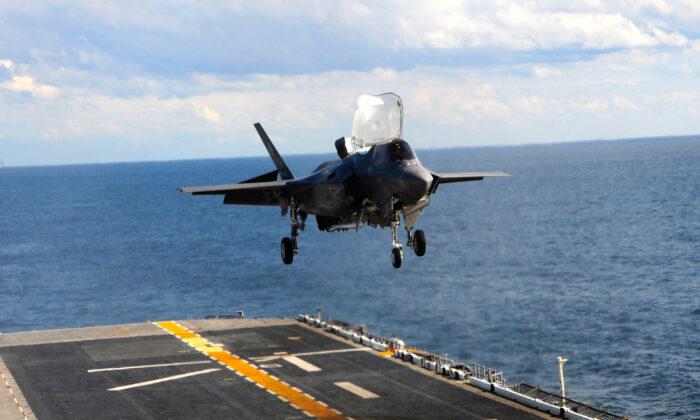A new government report has found that U.S. F-35 fighter jets are only ready for a mission about half of the time, with the remaining time spent awaiting maintenance.
The F-35—which is operated by the U.S. Air Force, Navy, and Marine Corps, as well as a host of U.S. allies—is one of the most advanced systems in Western arsenals. The 5th Generation fighter jet is made with an array of special radar-absorbent materials and other “stealth” features. The multirole fighter jet boasts capabilities for a range of different mission types, and the F-35B variant operated by the Marine Corps has unique short take-off and vertical landing capabilities.
The F-35 is also one of the most expensive systems in Western arsenals. The U.S. Department of Defense has estimated the F-35 program will cost the department about $1.7 trillion over its life cycle. A majority of this estimated lifetime cost, $1.3 trillion, is expected to go toward maintenance. The GAO said it conducted this latest sustainment study of the F-35 in part because of this high program cost.
Contributing to this low mission capability rate, the GAO report concluded the F-35 program is heavily reliant on contractors for maintenance work and the DOD has been slow to take over the program’s responsibilities.
The GAO report said the DOD is still working to determine the right balance of government and outside contractor roles to sustain the F-35 program going forward. The DOD also lacks both the technical data and training to support its desired program sustainment model.
While the GAO report identifies challenges with the F-35 program, it also describes an opportunity to overhaul the program to both bring down costs and improve the maintenance process that drags on it.
Repairs Department on Secretive Spare Parts List
The new GAO report derived its conclusions about the F-35 program over the course of visits to two military F-35 depots and three military installations that host F-35 squadrons. A recurring problem for military aircraft maintainers at these depots and installations have limited information about the spare parts needed to keep their aircraft running.The list of parts for the F-35 program is maintained in a database that is proprietary to the program’s prime contractor, Lockheed Martin Corporation. With all this proprietary information, the military has to outsource much of its maintenance to Lockheed Martin and its subcontractors.
Not having ready access to part numbers hinders the repair of the aircraft because it delays the ordering and receipt of needed parts,“ the GAO report states. ”Maintainers at one installation we visited told us that they would not need contractors on the flight line if they simply had access to part numbers. However, since access to part numbers is an issue that can affect readiness of the aircraft, units and squadrons need contractors on a daily basis.”
In a press statement to NTD News, Lockheed Martin spokesperson Jacqueline Lorenzetti said the corporation provides “all data required under its F-35 government contracts and is committed to providing data required for the Department of Defense to sustain the aircraft under applicable sustainment contracts.”
Ms. Lorenzetti said the U.S. government has unlimited access to all Operation, Maintenance, Installation, and Training (OMIT) data for the aircraft. She also said 90 percent of parts in the F-35 program are performing better than expected and the average time that parts remain on F-35 aircraft before failure is more than twice that of a typical 4th Generation fighter jet.
The GAO report provided a list of recommendations, advising the military to assess whether they or private contractors will take primary responsibility for various components of the F-35 program, as well as what resources and proprietary information the Department of the Air Force and Department of the Navy will require for these revised responsibilities.Ms. Lorenzetti said Lockheed Martin is partnering with the government to increase repair capacity for the F-35 fleet.
“We stand ready to partner with the government as plans are created for the future of F-35 sustainment ensuring mission readiness and enabling deterrence,” Ms. Lorenzetti said.







